You Be the Judge: Brown Recluse on the Loose
In April 2005, Chad Cook bought a home in Anderson, Indiana, and moved in with his pregnant wife and their 1- and 3-year-old children. While Cook noticed spiders during his initial inspection, he assumed they were ordinary household spiders. By August, he began to suspect they were dangerous brown recluse spiders. Experts at Purdue University confirmed his suspicion in September and advised Cook to immediately move his family out of the home.
That month, Cook contacted his insurer, Allstate, requesting coverage — a request he continued to make by telephone and in person over the next eight months, to no avail.
In the meantime, Cook had the home treated by pest control professionals. In December 2005, he moved his family back into the house but, finding more spiders, moved out again the next week. Thereafter, Cook hired various professional exterminators to treat his home, but the brown recluse problem persisted.
On June 23, 2006, Allstate finally responded to Cook’s claim. In the letter, the company denied coverage based on Allstate’s exclusion for losses “consisting of or caused by … insects, rodents, birds, or domestic animals.”
Cook filed suit against Allstate seeking coverage under Allstate’s Deluxe Homeowners Policy for an infestation of brown recluse spiders at his home. Cook claimed that Allstate’s “insect” exclusion did not apply because spiders are not insects, but belong to a class of animals known as arachnids. He cited encyclopedias, a dictionary, and scientific articles to establish that spiders are not insects. For example, spiders have two main body parts; insects have three. Spiders have eight legs; insects have six.
In response, Allstate quoted one Merriam-Webster definition of insects as “any of numerous small invertebrate animals (such as spiders or centipedes) that are more or less obviously segmented.” Allstate also argued that an infestation of brown recluse spiders was not covered under the policy because there was no “sudden and accidental direct physical loss” to the property; in short, no event or disaster caused damage to the home.
How Would You Rule?
In its decision, the court cited Indiana case law establishing that if any ambiguity exists in a policy term, and particularly in an exclusion, the term must be interpreted in favor of the policyholder and ruled that spiders were not excluded and should be covered by Allstate.
The court further found that a physical condition that renders property unsuitable for its intended use constitutes a “direct physical loss” even when the building’s structural integrity remains. “Brown recluse spiders living, breeding, and hunting on and within surfaces of the home are a physical condition that renders the home unsuitable for its intended use. The undisputed evidence is that the brown recluse spiders make it unsafe for Cook and his very young children to live in the home.” The Court entered a partial summary judgment in favor of Cook, but Allstate settled the suit before trial.
—Cook v. Allstate 2007
Addendum: Across the nation, companies are filing insurance claims for business interruption losses due to government-mandated closure of nonessential businesses because of the COVID-19 pandemic. The insurance industry is denying these damage claims because businesses have not suffered any “direct physical loss,” such as from a fire or flood. Businesses are fighting back in court, arguing that the presence of a contaminant — whether a chemical agent or a contagion such as COVID-19 that can survive on doorknobs, faucets, phones, toilets, and other surfaces in buildings — constitutes direct physical loss or damage to the property, triggering business interruption coverage.
This article is featured in the July/August 2020 issue of The Saturday Evening Post. Subscribe to the magazine for more art, inspiring stories, fiction, humor, and features from our archives.
Featured image: Shutterstock
You Be the Judge: Reader Favorite: Looking for a Fair Way
In 1977, Nebraska businessman and avid golfer Dennis Circo developed an exclusive residential neighborhood dubbed Skyline Woods. Its centerpiece was an 18-hole golf course. As the developer, Circo sold lots, built homes, and transformed the golf course into a country club, adding a clubhouse, pool, and tennis courts. With all of its amenities, buyers paid a premium for home lots.
By 1990, Skyline Woods was well established, with 90 homes built around the country club, and Circo thought the time was right to sell the club to a golf course management company. Unfortunately, the golf pros ran into financial hazards. They ran out of “green,” and the only course of action was for Skyline Woods Country Club to file for bankruptcy in 2004. To pay off debt, the bankruptcy trustee auctioned off the property in 2005. A group of Skyline Woods homeowners tried to buy the club, but were outbid by Liberty Building Corporation, a development company owned by David Broekemeier.
Here’s where things got sticky. The federal bankruptcy court transferred property to Liberty, free and clear of all obligations. Shortly after, Broekemeier met with homeowners and club members to inform them he had no obligation to honor memberships, offering the option to play the course if they paid fees like anyone else.
If that was bad, what happened next was worse. In spring 2006, Broekemeier closed the club, posted “no trespassing” signs, and began cutting down trees to clear land where he planned to build a condominium complex and water park. Teed-off homeowners sued Broekemeier in Nebraska State Court, requesting a restraining order to prevent further damage to the land. They claimed implied covenants as homeowners in the golf community guaranteed the only use of land was as a golf course.
They reasoned Broekemeier might own the golf course free and clear but was free only to use it as a golf course. Homeowners added that no matter how you slice it, Broekemeier was well aware of their covenants, as he had also built a golf community adjacent to Skyline Woods. And, like Circo, he marketed the course’s proximity and views to sell lots. And there were rumors that he was going to redirect the golf course toward his neighborhood, leaving Skyline Woods homeowners with views of condos and a water park.
In response, Broekemeier came out swinging with a motion to dismiss the case. His first argument was that the state court had no jurisdiction to interfere with the federal bankruptcy order. Second, even if the state court did have skin in the game, the covenants were unenforceable because they were never recorded. Finally, he said Nebraska law protects bona fide purchasers from restrictive covenants when there is no notice.
How Would You Rule?
District Court Decision — 2008:
Round one was won by the homeowners. A Nebraska court found that they did indeed have implied restrictive covenants; Broekemeier was aware of the covenants; and finally, the bankruptcy sale of the property did not discharge the covenants because they belonged to the homeowners, not the golf course. The court ordered Broekemeier to either reopen the golf course or maintain it in a fashion that would not devalue the property of homeowners. Broekemeier chose the latter.
Round two: After six years of legal turf wars, the golf course never reopened, eventually becoming an eyesore due to lack of maintenance.
Aftermath — 2012: Game over. The land was sold. At that time, the new owner planned to spend $7 million to build a premier golf course.
This reader favorite originally appeared in the July/August 2012 issue of The Saturday Evening Post and was republished in the May/June 2020 issue. Subscribe to the magazine for more art, inspiring stories, fiction, humor, and features from our archives.
Featured image: Shutterstock
Cartoons: Laughed Right Out of Court
Want even more laughs? Subscribe to the magazine for cartoons, art, inspiring stories, fiction, humor, and features from our archives.
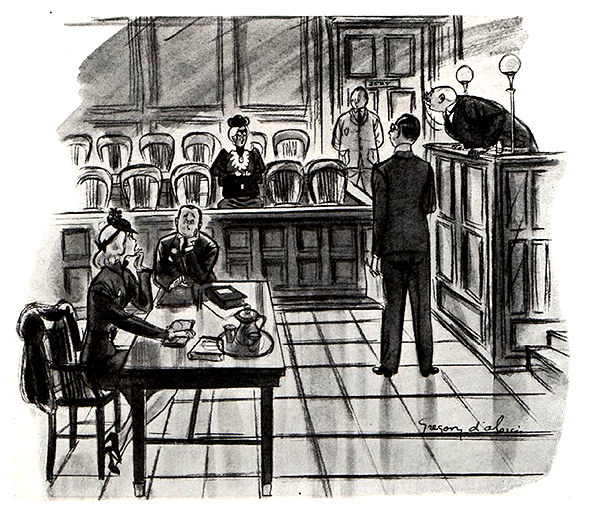
Gregory Dalescu
November 25, 1939
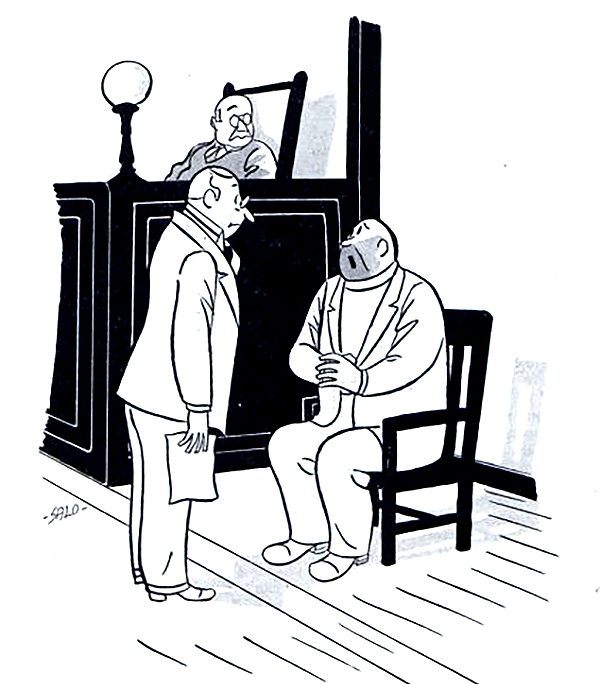
Salo Roth
November 18, 1944
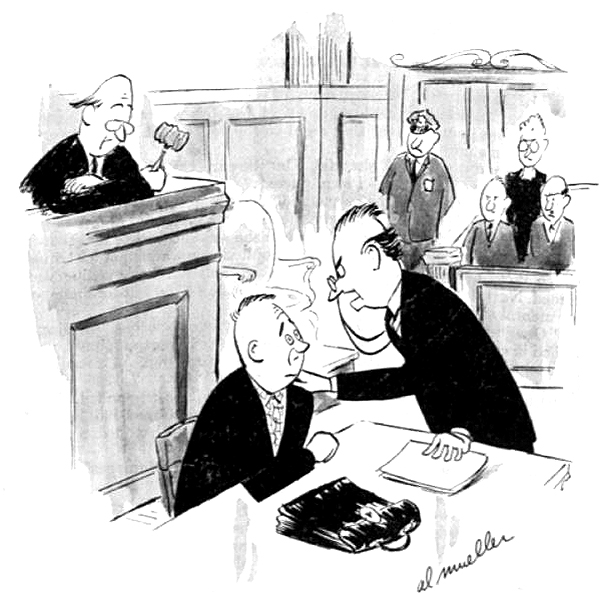
Al Mueller
October 27, 1951
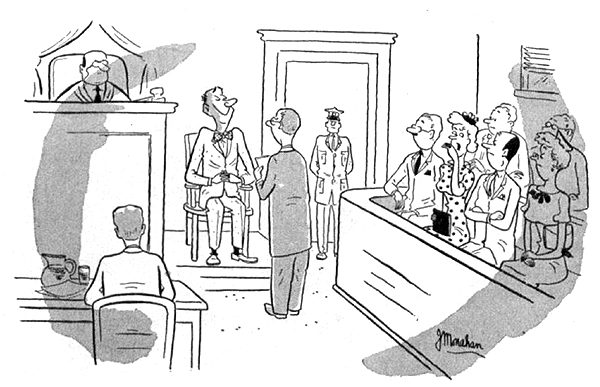
J. Monahan
May 10, 1952
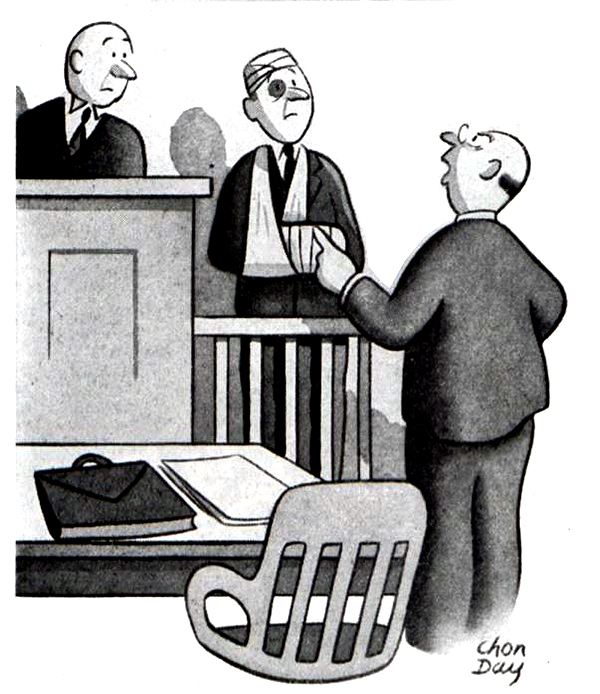
Chon Day
February 10, 1940
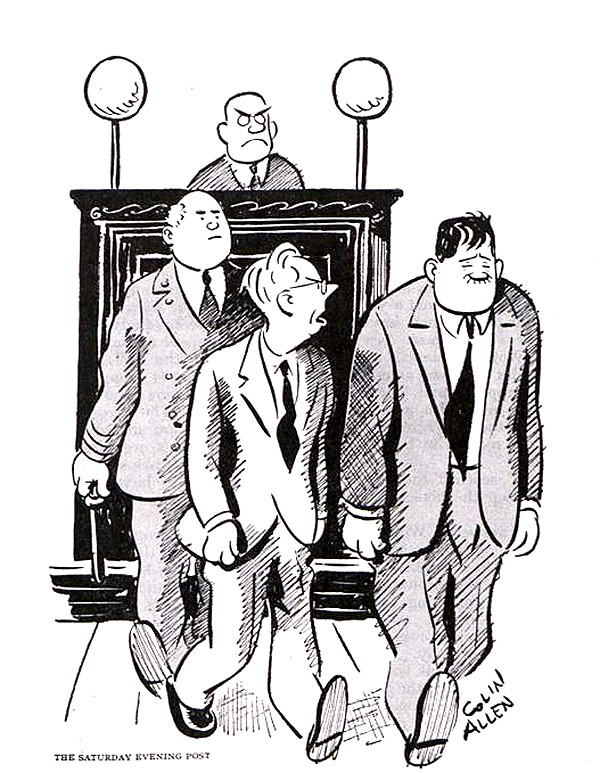
Colin Allen
January 13, 1945

Glenn Bernhardt
December 1, 1951
Want even more laughs? Subscribe to the magazine for cartoons, art, inspiring stories, fiction, humor, and features from our archives.
You Be the Judge: Fax and Fiction
Matthew and Marcia Seebachan were traveling in their Honda Fit on a 75 mph stretch of road in 2013 when a Toyota Tundra traveling in the oncoming lane hydroplaned into their path, causing them to T-bone head-on into the right front quarter of the Tundra. The impact of the collision crumpled the front of the Honda, pinning them both in the car. Another motorist rescued Marcia through the passenger window, but Matthew was trapped behind the steering wheel as flames from the ruptured fuel tank below his seat engulfed his legs and feet. They both survived but were badly injured. Matthew suffered numerous broken bones, internal injuries, and fourth-degree burns all over his lower body, which left him with irreparable nerve damage and excruciating pain. Marcia also sustained multiple internal injuries and required surgery to place a stent in her aorta.
The Seebachans had purchased the used Honda Fit four months earlier. Before buying the car, they received a CARFAX report indicating the car had not had any major maintenance or repairs. So, after the accident, they were surprised to learn the car’s previous owner had taken it to John Eagle Collision Center in Dallas to replace the roof after a hailstorm in 2012.
Further investigation of the previous repair work uncovered that the Collision Center had ignored the Honda Fit Body Repair Manual, which requires the new roof they’d installed be welded to the car. Instead, the Collision Center used a bonded adhesive to glue the roof onto the car.
The Seebachans filed a negligence lawsuit against John Eagle Collision Center for damages as a result of improper repair of their Honda. Their expert witness testified that the improperly repaired roof caused it to buckle, which led the car’s safety cage to collapse and the fuel tank to rupture. They asked for $42 million — calculated to equal 5 cents for every second of Matthew’s life expectancy.
John Eagle admitted they did not follow Honda’s specifications. In their defense, the body shop director testified that the State Farm Insurance adjuster who represented the insured directed them to use adhesive rather than spot welding. When questioned whether they were forced to follow the insurance directive rather than the manufacturer’s specifications, he said yes — if they wanted to get paid. He explained that since insurance companies pay the bills, insurance adjusters are able to dictate repair specifications. The Collision Center defended the method they used to repair the roof, arguing it was safe and that the damage to the Honda Fit was caused by the collision and could not be attributed to the roof repair.
How Would You Rule?
A jury in the District Court of Dallas awarded $41.966 million to the Seebachans. The John Eagle Collision Center was responsible for 75 percent of the judgement — nearly $31.5 million in damages. The jury attributed the other 25 percent of the blame to the Tundra driver.
In a separate case, the Seebachans sued State Farm Insurance for their role in the negligent repair. Their attorney stated, “John Eagle did not repair the subject 2010 Honda Fit to Honda’s body repair specifications due to State Farm’s instructions, threats, and/or coercion.” State Farm denied that it forced John Eagle to use deadly, dangerous, unproven, and untested adhesive rather than welds. That case was settled out of court.
—Matthew and Marcia Seebachan v. John Eagle Collision Center, 2017
This article is featured in the November/December 2019 issue of The Saturday Evening Post. Subscribe to the magazine for more art, inspiring stories, fiction, humor, and features from our archives.
Featured image: Shutterstock.com
You Be the Judge: Who Got (Your) Mail?
After John Ajemian was tragically killed in a bicycle accident in 2006, his brother Roger, who had set up an email account for his brother in 2002 and occasionally shared it, wanted to access the account in order to contact John’s friends and associates about his untimely death. Unfortunately, Roger could not remember the password.
John, 43, died without a will and left no instructions regarding his property, including how to access his Yahoo email account, so Roger and his sister, Marianne, who were appointed as coadministrators of John’s estate, requested assistance from Yahoo. In response, Yahoo declined to provide access to the account, citing a federal law, the Stored Communications Act (SCA), which prohibits providers from disclosing the contents of electronic communications stored in their system unless there is lawful consent by the owner of the content. Yahoo explained it could provide basic subscriber information if they had a court order mandating disclosure to the account holder’s personal representatives, but cautioned that even with such an order, Yahoo’s Terms of Service (TOS) agreement governing John’s email account provided Yahoo with the discretion to reject the personal representative’s request.
In 2007, the administrators filed a complaint in the Probate and Family Court of Norfolk County, seeking to compel Yahoo to disclose John’s account records. Yahoo provided them with John’s subscriber information and email header data, but not the emails themselves. In 2009, the administrators filed a second action seeking “complete and unfettered access to the contents of the account,” claiming that the emails were property of John’s estate and that its administrators should have unlimited access to the content of the account.
The parties were in litigation for nearly a decade. The ultimate question was whether John’s emails were property of his estate and, as such, an administrator or executor could give consent to release the digital assets in accordance with the Stored Communications Act.
Throughout the proceedings, Yahoo claimed no ownership of John’s email content before or after his death. Yahoo maintained that according to the TOS agreement, John’s email account was not transferable and should have been terminated and the contents deleted upon receipt of the death certificate. The company maintained that the comprehensive set of privacy rights of the SCA should be followed, arguing that any exception by a probate court would degrade the privacy of millions of Americans the moment they die. In this case, they warned, complete control to publish or keep the emails confidential shifts to the estate administrator, who could be a trusted family friend or a complete stranger to the decedent.
How Would You Rule?
On October 16, 2017, the Supreme Judicial Court of Massachusetts held that personal representatives may provide lawful consent on a decedent’s behalf. The issue of the enforceability of Yahoo’s Terms of Service agreement was remanded to the Massachusetts Probate and Family Court for further proceedings. On March 26, 2018, the United States Supreme Court denied Yahoo’s appeal.
With many legal issues yet to be decided, people should create a plan for digital assets in the same way they would treat any other valuable tangible or intangible asset.
This article appears in the September/October 2018 issue of The Saturday Evening Post. Subscribe to the magazine for more art, inspiring stories, fiction, humor, and features from our archives.